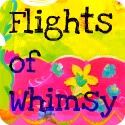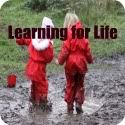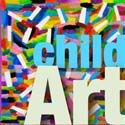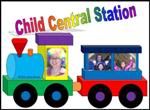
Children hold many misconceptions about the world in which they live. Let’s explore a few examples:
SOPHIE TAKES A MEASURE OF THE WORLD.
Louise is in the garage sanding a TV stand she plans to paint. The back door opens and her husband calls, “Here comes your helper!” Four-year-old Sophie comes out of the house carrying a tape measure. “Come on over”, her mother says.
Sophie immediately begins to measure the TV stand, laying the tape measure across the top. Her mother continues sanding. “It’s 32 metres”, Sophie reports.
Next she measures up the front of the stand and determines, “It’s 5 Kilo’s”.
Finally, Sophie ducks behind the stand, places the tape measure across the back, and announces, “It’s 20 to 5!”
WHERE DO DREAMS COME FROM?
A four year old explained the occurrence of dreams in this way:
“It’s when somebody comes into my room when it’s dark and I’m asleep and shows a DVD on the wall”.
GETTING INSIDE THE T.V.
A three-year-old child is reprimanded by her father for playing with the electrical cords at the back of the television. When the father asked the child for an explanation as to why she was behind the television, she promptly replied:
“I was trying to open the door to get the ‘Princess Barbie’ out!”
PICKING GREEN TOMATOES.
A little girl remembers the fun she had on the weekend helping Daddy in the garden and how delighted he was to have her help. She decides to give Daddy a nice surprise when he comes home from work and picks all the green tomatoes for him.

MY FRIEND THE MOON.
Similarly, a child travelling in a car at night might decide that the moon is following him. It seems quite logical really, all the trees and houses are whizzing past at great speed but the moon is always there!
As adults, we may be tempted to regard these misconceptions as comical or mildly amusing, but the reality is, significant brain activity is taking place in each scenario. Each child is using their information processing capacity to gain a greater understanding of their world. Each child is analyzing their observations and formulating an understanding that ‘best fits’ with their current and limited knowledge base.
NOW, LET’S PLACE OURSELVES IN THEIR SHOES.
THE “BLANK SLATE”.
John Locke (1632-1704), a leading British Philosopher, was the forerunner of some of our twentieth century perspectives on child development. Locke viewed the child as a “tabula rasa”. Translated from Latin, this means a “Blank Slate” or “White piece of paper”.
We know that a new-born child commences life with minimal prior knowledge or experience of the nature or complexity of the world in which they live. However, they are endowed with a CNS (Central Nervous System), an asset with incredible potential for accumulating and processing incoming sensory data and experiences. Recent neurological discoveries relating to the nature of brain development in the first few years of life, have provided us with an understanding of the critical importance of the provision of high quality early childhood education.

In an article published in Time Magazine, FERTILE MINDS, by J Madeleine Nash (Time 1997), she makes the following assessment of the importance of providing rich and stimulating learning environments in the early years:
“During the first years of life, the brain undergoes a series of extraordinary changes. Starting shortly after birth, a baby’s brain, in a display of biological exuberance, produces trillions more connections between neurons than it can possibly use. Then, through a process that resembles Darwinian competition, the brain eliminates connections, or synapses, that are seldom or never used. The excess synapses in a child’s brain undergo a draconian pruning, starting around the age of 10 or earlier, leaving behind a mind whose patterns of emotion and thought are, for better or worse, unique.
Deprived of a stimulating environment, a child’s brain suffers. Researchers at Baylor College of Medicine, for example, have found that children who don’t play much or are rarely touched develop brains 20% to 30% smaller than normal for their age. Laboratory animals provide another provocative parallel. Not only do young rats reared in toy-strewn cages exhibit more complex behaviour than rats confined to sterile, uninteresting boxes, researchers at the University of Illinois at Urbana-Champaign have found, but the brains of these rats contain as many as 25% more synapses per neuron. Rich experiences, in other words, really do produce rich brains.”
So, over a person’s lifetime, the CNS functions to build up an understanding of the world in which they live. The CNS collects, processes and accommodates new information constantly. Hypotheses, concepts or misconceptions are continuously being formulated, or discarded. The provision of a rich and stimulating learning environment in the early years, will result in more powerful, flexible and resilient brain development, thus maximizing the brains information processing capacity.
When children enter their 3rd or 4th year, their life experience and therefore understanding of the world, remains fairly limited. As a result, young children hold many “misconceptions” about the physical and social environment in which they live.
MISCONCEPTIONS: A false or mistaken view, opinion or attitude.
When new information enters the CNS of a child, the information will be examined through a process known as “accommodation”. A child will attempt to create a “fit” with what they already know. Learning is a process of making connections between new information and existing understandings.
ACCOMMODATION: Adjustment, as of differences or to circumstances; adaptation, settlement or reconciliation.

THE PUZZLE PIECES COME TOGETHER
I like to use the analogy of a jigsaw puzzle in visualizing the manner in which knowledge and understandings are accumulated throughout a life time. Picture one of those large and intricate 5000 piece puzzles that sits on the dining room table for months on end and seems to take something akin to a lifetime to complete. Imagine the bare table prior to commencement,as the newborn child’s ‘tabula rasa’ or ‘blank slate’ and each puzzle piece as representing an understanding or piece of knowledge. As the child is exposed to, and engages with its environment, pieces of the puzzle one by one begin to be put into place. But in the early days, large blank spaces still remain with very few pieces having been connected. It is at this point the child has to play around with the puzzle pieces to try to make connections. Errors are often made and incompatible pieces are sometimes inaccurately aligned. Through trial and error and constant exposure and engagement with new experiences the puzzle starts to fall into shape and an accurate image begins to appear.
IS THE PUZZLE EVER COMPLETE?
The ‘real’ one, clearly the answer is no! If we look at the historical attempts of the human race to understand aspects of their world we may ‘now’ view their misconceptions as comical or mildly amusing. Over time, advances in technology have allowed the accumulation of new knowledge to dispel many strongly held misconceptions.
It took the Spanish Expedition of “Christopher Columbus” in 1492 to dispel the fiercely held belief that the earth was flat.
In 1543, just before his death, Nicolaus Copernicus, published a book with a radical new theory proposing that the Earth, like all other planets, revolved around the Sun. In 1600 Giordano Bruno was burnt alive ‘at the stake’ by the catholic church for his support of the work of Copernicus!
I am sure that future generations will look back in disbelief at some of our generations misconceptions.

DEFINING A RICH AND STIMULATING ENVIRONMENT
So recent research on brain development is highlighting the importance of the early years for the development of complex neural pathways. Although the brain is not a passive organ and is developing regardless of external stimulation, a quality learning environment can help to optimise this development.
So what is a rich and stimulating environment NOT:
-
Step away from the temptation of fast paced, flashy light, kaleidoscope colour and disco-ball style stimulation. Am I referring to screen time (the television, I-pad, X-box and Playstation)? Yes indeed I am! Current research is telling us that this is not what young children need.
-
Step away from the temptation of the ‘over-scheduled child’. The ludicrous phenomena of allocating formal activities to every waking moment of a child’s life. Activities such as swimming lessons, ballet classes, martial arts and gymnastics, striping away any opportunity for free time in which a child can just ‘be’.
-
Step away from the temptation to ‘push-down curriculum’. The desire to get children versed in the 3R’s well before it is developmentally appropriate and beyond their capacity to accommodate.
Now clearly, the above summation of what a rich stimulating environment is ‘not’, is biased according to my own philosophical perspective. So let’s now have a look at what cannot be ‘argued’ against or misconstrued by personal philosophy.

The social environment:
The work of Vygotsky and Bronfenbrenner highlighted the importance of the social and cultural environment in the learning and development of young children. In the early childhood field we are well aware of the need for an environment that is rich in stimulating dialogue. Interactions that are reciprocal, respectful and genuine. Interactions that support, ‘scaffold’, extend and nurture the emerging interests of children. Few early childhood professionals would deny the importance of this.
But what else is crucial to the provision of a rich and stimulating environment for children? Again, research is telling us that a return to engagement with, and exposure to, the ‘natural environment’ is of paramount importance for healthy brain development in young children. It is an environment that allows time to explore, engage, observe, think and reflect. It is steeped in wonder and promotes imaginative and creative endeavour. It is rich in sensory experiences that promote a life long connection and love for its unique beauty.

Children have an innate affinity with the natural world:
According to an article by Randy White & Vicki Stoecklin, Children’s Outdoor Play & Learning Environments: Returning to Nature;
“Children have a unique, direct and experiential way of knowing the natural world as a place of beauty, mystery and wonder. Children’s special affinity for the natural environment is connected to the child’s development and his or her way of knowing.” (White & Stoecklin)

Respecting the child’s way of knowing:
In an article by Ruth A. Wilson Ph.D., The Wonders of Nature: Honoring Children’s Ways of Knowing, she draws attention to children’s deep connection with the natural world;
“Researchers who have studied how children know and perceive the world suggest that my experience is shared by children across different cultures. Rachel Sebba (1991), a researcher from Israel, investigated children’s relation to the environment from actual and retrospective points of view. In conducting her research, Sebba looked at the environmental preferences and the nature of the experiences of being outdoors as reflected in adults’ recollections and in children’s actual approaches to investigating the world. Her findings suggest that children experience the natural environment “in a deep and direct manner, not as a background for events, but, rather, as a factor and stimulator (p. 395).
Sebba’s findings are consistent with the work of Edith Cobb (1977), who concluded from her research that “experience in childhood is never formal or abstract”. “Even the world of nature,” she says, “is not a ‘scene,’ or even a landscape. Nature for the child is sheer sensory experience” (pp. 28-29).
 Well if you have made it this far, I am so pleased that your interest in what I have had to say has encouraged you to soldier on through what ended up being quite a lengthy post! Phew! Please feel free to leave a comment if you have any thoughts, questions or challenges you would like articulate in response. 🙂
Well if you have made it this far, I am so pleased that your interest in what I have had to say has encouraged you to soldier on through what ended up being quite a lengthy post! Phew! Please feel free to leave a comment if you have any thoughts, questions or challenges you would like articulate in response. 🙂














































